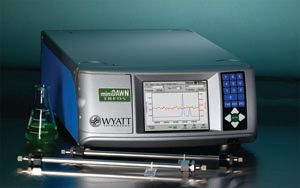SEC-MALS Detector
The miniDAWN& reg ; TREOS? is a multi-angle (three-angle) light scattering (MALS) detector that can be coupled to any liquid chromatograph (HPLC/GPC/SEC/FPLC) or used off-line in a ?micro-batch? mode for determining the absolute molecular weights and sizes of polymers or biopolymers directly, without resorting to column calibration or reference standards

The miniDAWN® TREOS™ is a multi-angle (three-angle) light scattering (MALS) detector that can be coupled to any liquid chromatograph (HPLC/GPC/SEC/FPLC) or used off-line in a “micro-batch” mode for determining the absolute molecular weights and sizes of polymers or biopolymers directly, without resorting to column calibration or reference standards.
In biotechnology applications, the miniDAWN reveals aggregation phenomenon that are usually not detected by UV, RI, or NMR instruments. And, unlike mass spectrometry, the miniDAWN tells how molecules are behaving in solution. In addition, the miniDAWN enables the user to study aggregation, kinetics and reaction rates as they occur.
The TREOS has four auxiliary inputs for RI, UV, or other instruments. It also has a 60mW GAaS laser with spatial filtering for the highest possible signal-to-noise. The instrument has been ergonomically designed for “plug-and-play” functionality. It has on-board analog-to-digital conversion, and outputs its serial stream of data to any PC.
In addition, the TREOS has a bright, 64,000 color LCD display that shows current system states, chromatographic conditions, and more.
The TREOS instruments join Wyatt Technology’s unique light scattering systems which include the DAWN HELEOS, as well as the Optilab rEX—the only refractive index detector available that can be built to operate at any wavelength selected by the customer.
Contact: Geofrey Wyatt
Tel: 805-681-9009
FAX: 805-681-0123
E-mail: info@wyatt.com
Investigating 3D-Printable Stationary Phases in Liquid Chromatography
May 7th 20253D printing technology has potential in chromatography, but a major challenge is developing materials with both high porosity and robust mechanical properties. Recently, scientists compared the separation performances of eight different 3D printable stationary phases.
Detecting Hyper-Fast Chromatographic Peaks Using Ion Mobility Spectrometry
May 6th 2025Ion mobility spectrometers can detect trace compounds quickly, though they can face various issues with detecting certain peaks. University of Hannover scientists created a new system for resolving hyper-fast gas chromatography (GC) peaks.
University of Oklahoma and UC Davis Researchers Probe Lipidomic Profiles with RP-LC–HRMS/MS
May 6th 2025A joint study between the University of Oklahoma Health Sciences Center (Oklahoma City, Oklahoma) and the UC Davis West Coast Metabolomics Center (Davis, California) identified differentially regulated lipids in type 2 diabetes (T2D) and obesity through the application of reversed-phase liquid chromatography-accurate mass tandem mass spectrometry (RP-LC-accurate MS/MS).

.png&w=3840&q=75)

.png&w=3840&q=75)



.png&w=3840&q=75)



.png&w=3840&q=75)



